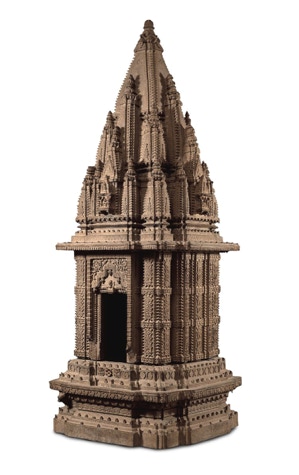IV. VERTICAL & EMERGENT EXPANSION:
Dharmaraja Ratha and Rajarani Temple

SHIV MANDIR, “TEMPLE OF STONE AND LIGHT,” BARMER, RAJASTHAN (2016.)

ANTEFIX OF SHIVA SHRINE, SEKHARI WITH THREE URUSHRINGAS, BRITISH MUSEUM, c.1150.
The preceding two examples of “aedicular addition” or “linear expansion” account for many temples’ horizontal extension but the vertical dimension is at least as important in Indic temple architecture due to the symbolic import of its tower as representing Mt. Meru, the mythic home of the Indo-European, Vedic deities. Its upper slopes were imagined to be populated by the palaces of the gods and its foothills by superhuman guardian spirits, wind nymphs and even demons. Humans, giants, animals and “hungry ghosts” were consigned to live at sea level on four continents in a vast ocean separated from the holy mountain by six concentric mountain ranges divided by six seas, like ripples spreading out from the primal bindu or drop into materiality from the mountain’s niskala (dimensionless) apex. Buddhism adopted Mt. Meru as a symbol for its thirty-one (or thirty-three) increasingly rarefied or dematerialized levels or “worlds” of consciousness which because of that religion’s extreme idealism are synonymous with ontological modes of being, (see appendix I. ”Buddhist Cosmology.”) These are divided into three larger categories, realms or dhatus: the kamadhatu or “desire realm” on the mountain itself and the rupadhatu and arupadhatu, the “form” and “formless realms,” hovering in layers thousands of miles above its still-material summit. The ascent of the mountain and the spaces above it can therefore be correlated with the stages of progressive purging of samsaric consciousness or self-attachment which the soul of an ascetic, Theravada arhat or Mahayana bodhicitta, must pass through to reach moksha, release, or parinirvana, non-existence.
Cave or Peak?
The Garbagriha/Shikhara Dichotomy
The towers, or shikharas, of Indian temple mountains were composed of layers of miniature shrines or palaces, where the gods resided and where their darshan, sight or presence, could bless the puja, the prayers and offerings, of their devotees. These aedicules or miniature shrines were therefore images of the actual shrine whose tower’s tiers they lined, just as the shrine itself could be thought of as an “aedicule” or miniature version of Mt. Meru with its slopes covered with celestial palaces. This interplay between simulacrum and original, manifest and concealed, is characteristic of Hindu and Buddhist ontology.
The tension between the horizontal attraction of the garbagriha and the directionality of the “liturgical axis” and the vertical upthrust of the shikhara, soaring free from gravity, suggests an inherent contradiction in Indic and perhaps all religions. Anthropologists have proposed an ethnographic explanation for these contrasting impulses in Hinduism. They identify the garbagriha and its chthonic recesses with a pre-Vedic substrate, the cultures which preceded the Aryan migrations around 1500 B.C.E., still heard in the non-Indo European languages spoken in Southern India. Often lumped together as “Dravidian,” this earlier population may have been related to an advanced, agrarian, Bronze Age civilization, the Harappan, which flourished between 3300 - 1300 B.C.E. in the Indus Valley region of today’s Pakistan and northwest India. This in turn may have been influenced by developments in the contiguous and contemporaneous states and cultures of Mesopotamia, Egypt and the Mediterranean Basin. Marija Gimbutas postulated that these agriculturalists (who also developed the first urban centers) worshipped vegetative deities centered around a Great Goddess cult of “mother earth.” Indeed, Shiva, the “Great God,” seems not to have originated from the Vedic Pantheon but as a fertility deity, perhaps related to the “god that dies”only to be resurrected each spring in Fraser’s Golden Bough, e.g., Osiris, Tammuz, Adonis and, some would argue, Christ. A banalinga or svayambhulinga, a natural rock shaped like Shiva’s aniconic linga, is especially venerated because it comes from deep in the earth, supporting the “Great God’s” telluric, vegetative and animist connections. Only later was Shiva syncretized with Rudra, the rude, the “roarer” and destroyer, the god of storms and wrath in the Rigveda.
Perhaps a vestigial sense that the sacred lies within the earth helps explain the persistence of “monolithic,” rock-cut temples in India, for example, the Buddhist chaitya halls and viharns at the Ajanta Caves (c. 200 B.C.E. - 460 C.E.) and the nearby Hindu (Saivite) Kailasa Temple at Ellora (756 - 773 C.E.,) whose plan copies two free-standing stone shrines, the Kailasanathar in Kanchipuram (685 - 705) and the Virupaksha at Pattadakal (745 - 754.) Similarly, the liturgical path from the bright, quotidian world outside the temple though the tenebrous mandapa to the dark recesses of the garbagriha or “womb chamber” could trace an atavistic return to the dark but fertile earth as home of the generative principle, an architectural “regression to the womb” or “womb chamber” and, ultimately, the primal soup or mud (the opposite of a building.) In Hindu philosophy the female principle, prakriti or nature, is associated with amorphous matter, as well as, its unreleased potential, which the male principle, purusha, must penetrate, like the light of dawn into the garbagriha, to fill the night with diurnal form and waken the god to shine his darshan on the day.
In contrast, the gods of Indo-European, nomadic pastoralists (and equally peripatetic Semitic monotheists) were not immanent in the arid earth they ceaselessly roamed, but transcendent in the sky above them – the sun, stars, raging thunderheads and ‘ever-homeless winds,’ anthropomorphized wanderers like themselves through mental and cosmic spaces. Their homes were mountaintops – Meru, Olympus, Valhalla – and their shrines, towers, pyramids and “temple mountains;” they made a religion out of verticality, of escaping the gravity of the earthly plain and plane. The Upanishads (TPQ 1000 B.C.E.) proceeded to dematerialize these aerial Vedic deities into the ideas they had always been and then generalized them into a universal mind, Brahman, divinity in the image of the mind of man. Reality became pure abstraction, unavoidably reminiscent of Plato’s nous and his eternal ideas pre-existing their thinkers. Thus “philosophical idealism” was born simultaneously in the East and West during what Karl Jaspers termed the Axial Age. Finally, Buddha, taking eidetic reduction to its logical extreme, reasoned that anything with attributes could also lose them and, since existence or being was an attribute, ideas, self, mind, indeed, all existents, were unreal illusions, maya. Since what comes into being, once was not, it could be not again; only sunyata, emptiness or non-existence, he concluded, endures, is indestructible and therefore real.*
Three millennia of thought condensed into the three paragraphs above can only parody philosophy, but they highlight a fundamental contradiction which both Indian and Khmer religion and their built expressions accommodate with surprisingly little overt conflict. Students of comparative religion have pointed out that most spiritual and metaphysical paths seek the same thing in the end – the extinction of individual existence and ephemeral differentiation for a return to a primordial, “uncreated” unity. The vertical alignment of the shikhara and garbagriha offers a merely architectural resolution of this binary, just as the naga or “rainbow bridge,” joining soil and sky through the “water cycle,” is merely a metaphorical (or meteorological) reconciliation of the chthonic and celestial. The mythic impulse to link earth and heaven is hardly limited to Southeast Asia; the feathered, flying serpent, Quetzalcoatl, and “vision serpents” were similarly a “sky umbilicus” between men and gods for the Toltecs and Terminal Classic Maya; the earlier Temple of the Sun (200 C.E.) at Teotihuacán was recently discovered to be built above a cave from whose hidden spring life-giving water and light were believed to flow; the origin of earth and space was a mountain.
The garbagriha, the small, unlit abode of an unthinkable, dimensionless (nirguna, niskala) divinity, prior even to the primal “dot,”“drop”or “seed,” has, not surprisingly, resisted visual and architectural elaboration. Shiva, the central deity of the Hindu Trimurti, was for centuries depicted only aniconically, not anthropomorphically, by a linga, a rounded phallic column. Buddha too could originally be signified only by his footprints , signs of his absence, or a tumulus concealing a relic, a hair or fingernail, the origin of the stupa. (Eventually, Buddha was endowed with no fewer than thirty-two distinguishing laksana, or physical marks of greatness, e.g. equal-length toes and fingers, an unisha or cranial protuberance, etc.) Indian and Khmer architects understandably focused their energy and imagination not on the garbagriha, but the shikhara, the vertical dimension, despite its more demanding tectonic challenges. In this respect they paralleled ecclesiastical architecture in the West with its Gothic vaults and spires, Brunelleschi and Bramante’s Renaissance domes, Pozzo’s and Tiepolo’s Baroque trompe l’oeil ceilings. South Asian sthapatis and sthapakas, (with the exception of Bagan) lacked the Roman arch and relied instead on corbelling, overlapping stone slabs, cramping their shrines’ interior spans and eliminating windows for massive load-bearing walls. This technological factor also concentrated their creativity on the temple’s exterior, compensating for the contracted internal spaces by the “aedicular expansion” of the outside walls and tower (shikhara, rekha deul, vimana, prang,) stringing horizontal tiers (pidas, bhumis, talas) and draping vertical bands (pagas, latas, bhadras) of aedicules, miniaturized versions of a repertory of shrines, above the cella or sanctuary, in dizzying variations.
*This argument obviously shares the contradiction inherent in any form of nihilism: how can one belief nothing exists without at least the existence of a mind to believe that? Consciousness may only be aware of illusions or projections, but consciousness itself cannot be one of them; the cogito, it would seem, always trumps the nihilo. Privileging the eternal as real and the ephemeral (everything experienced) as illusion seems intrinsic to the idea of an apophatic (non-manifest) absolute, a reification of the negation or inversion of the existent. Heraclitus (and modern physics) have proposed that change is the precarious “ground-of-being” or “reality.”